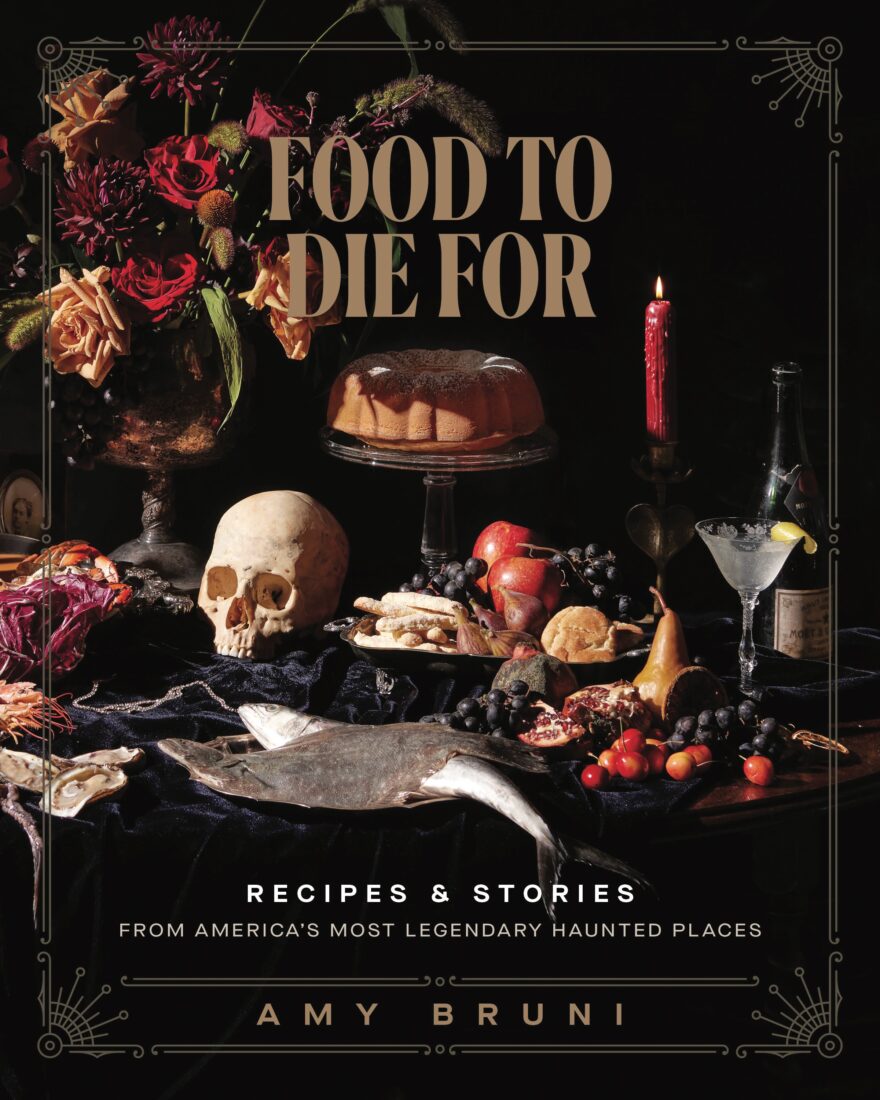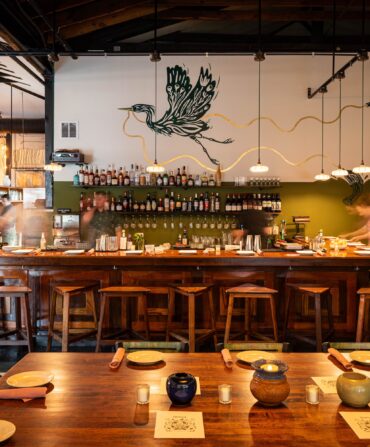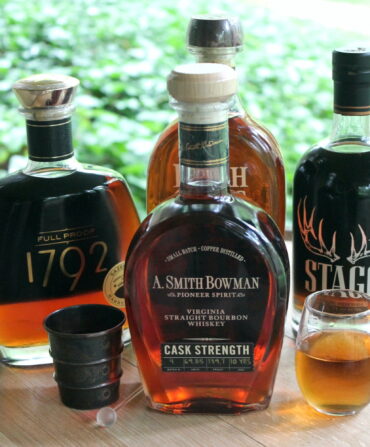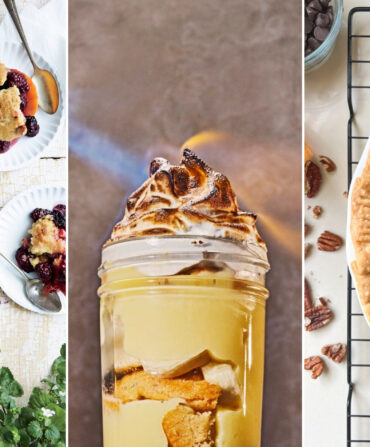Amy Bruni has always lived for the dead. Dubbed “ghost girl” by classmates growing up, Bruni spent her adolescent weekends hunting for otherworldly anomalies and researching historical hauntings with her father. She credits her interest to her first ghost encounter, at eight years old: a man dressed in all green floating above her garage in Alameda, California.

In the decades since, Bruni has starred in shows like Kindred Spirits and Ghost Hunters, hosted the Haunted Road podcast, and even founded the paranormal travel company Strange Escapes. But her newest adventure brings her from ghoulish destinations to the kitchen.
In her debut cookbook, Food to Die For, Bruni shares dozens of recipes from the country’s most spine-chilling locations, plenty of which, naturally, fall in the South. “You can read about a time and place, but tasting history is a much different experience,” she writes.
We spoke with Bruni about the making of a haunted cookbook, the relevance of historical recipes, and some of Louisiana’s ghostliest locales.

Let’s start at the beginning of the book and talk about its dedication to Lizzie Borden’s meatloaf.
The whole idea of this cookbook stemmed from seeing a recipe card for Lizzie Borden’s meatloaf. I remember looking at it, and a few things went through my head: A) That recipe doesn’t look very good and B) But she thought it was so good she wrote it down for people. If you made that, you would be tasting exactly what the Bordens tasted, smelling exactly what the Bordens smelled.
It’s different when you’re looking at artifacts or photos, but with food, if you prepare it exactly to their specifications, you are truly experiencing history. I was very inspired by thinking about Lizzie making this recipe, and I’ve also always had a close affinity for Elizabeth Borden. It just seemed fitting to dedicate the book to her memory and meatloaf recipe.
You have many years of paranormal investigation experience, but did you have any serious cooking experience before deciding to publish a cookbook?
I’ve always loved cooking. I’ve always loved going out to eat. I have no formal culinary training or anything like that, but I’ve been cooking for decades at this point.
I am very thankful and blessed that I was able to curate this cookbook because it’s just one of those things I took an interest in, kind of like the paranormal. I took an interest and turned it into a passion and then turned it into an actual thing.
What was it like when you brought the idea of a haunted cookbook to publishers?
I remember sitting in the driveway of my old house, talking to my manager about something, and I said, “Oh, by the way, I have this idea for a cookbook.” And he said, “That’s an amazing idea.” So I put together a book proposal and the first publisher took it to Harper Celebrate, and they were like, absolutely yes. They just got it.
Haunted or not, how do these historical recipes hold up to modern tastes?
Our food is better when we really pay attention to the quality of ingredients we’re putting in it. And I think in a lot of these historical recipes, it’s very clear you’re using fresh ingredients and it’s so much better for you. This is just a really great step back in time—obviously very spooky, but it’s historical cooking at its finest.
I would say about 80 percent of the recipes are delicious. And then there are a few in there that are very bare bones—you have prison food in there. So do your due diligence on what you choose to feed your family. Or, you know, some of these you could use as a consequence for your children. “Tonight, we’re having hardtack for dinner!”
How might the book resonate with non-believers?
Well, I will say I long ago stopped caring whether people believed in ghosts. I very much had this epiphany, and a lot of investigators do, where you think, Oh wait, I don’t need to prove this to anybody. I do welcome conversation, and that’s what I love about this book: Even if you don’t believe in ghosts, the history is there and it’s all accurate and it’s beautiful. You can read this book and get a ton of history out of it, some really fun spooky stories, and just stunning photography.
When investigating paranormal activity in the South, have you experienced a unique energy to the region?
I have been to New Orleans and Savannah a number of times, and I’ve investigated a lot of Southern locations. I consider New England and the South to be the two most haunted areas in the country. When people ask me, “What’s the most haunted place?” it’s those two areas.
The South is one of those areas that keeps me on edge as I’m investigating. I think anytime you have a situation where emotions or anxiety are running high, it creates an energy. Even if you don’t believe in ghosts per se, we’re always talking about manifestation and energy. So if you believe in that energy, then dark historical moments could very easily leave some of that energy behind and we could feel it. And so I do think in very tumultuous areas of the country, it’s a heavier feeling.
Let’s talk about one of the Southern locations and recipes from your book: crab soup from the Hermann-Grima House in New Orleans.
A lot of these historical locations, especially in the month of October, will place the whole house in mourning, and that’s what they do with this house. And it always makes me wonder how the spirits are reacting to that, seeing the whole house basically go dark.
The crab soup in particular was a really tough recipe because we adapted it from this book called the Creole Cookery. And it was basically journals of cooks going back a few hundred years, and it was one of the hardest things to take apart. It was literally along the lines of “go catch twenty-four crabs” and the wildest set of instructions. That recipe is probably the one we had to work on the most to adapt it into something we could all read today and understand.
The cookbook isn’t just limited to food. Another featured New Orleans spot is the Old Absinthe House, home of the absinthe frappé.
Thankfully we live in a time where you can actually buy absinthe and it’s not going to make you hallucinate. I love that this house has been in existence since the early 1800s, and I can’t even imagine if walls could talk, what went on in that building, especially during prohibition. To have cocktails bring all of these people together for so many hundreds of years is pretty wild to think about. That you could be sitting where people were sitting during the War of 1812 enjoying a drink.
And maybe the hardest question of all: What’s your favorite recipe from the book?
My favorite is actually the croissant bread pudding from the Myrtles [in St. Francisville, Louisiana] because it is sinful—truly to die for. The Myrtles is one of those very complicated hauntings because they have been telling stories for decades that did not happen there, like they’ve been reciting history that is proven to be false.
But it’s one of those weird things when you believe something to be true for so long, you almost manifest it in a way, and you almost create these ghosts of your own. I don’t doubt that it is haunted, but if you tell a story, does a ghost start to become something? Does that vision and that ghost start to kind of exist in some way? And so I think there’s something to that at the Myrtles for sure.
This interview has been edited for length and clarity.
Garden & Gun has an affiliate partnership with bookshop.org and may receive a portion of sales when a reader clicks to buy a book.








